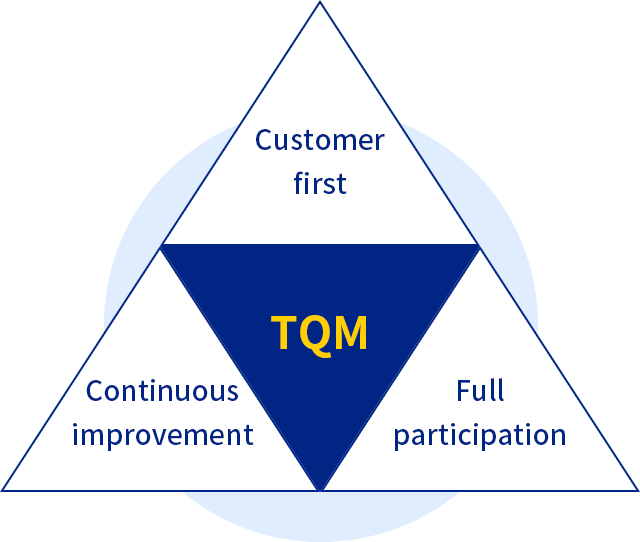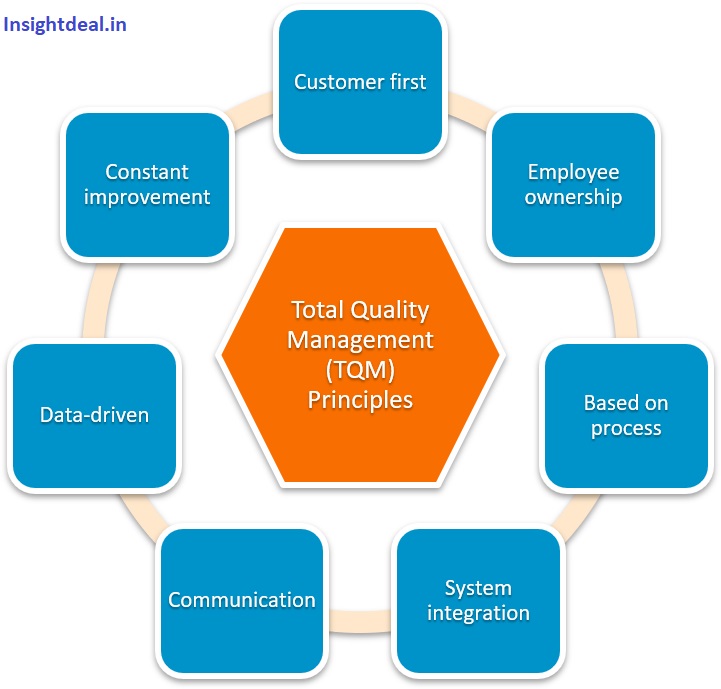Total Quality Management
Introduction to Total Quality Management (TQM)
Total Quality Management (TQM) is an approach to quality control that emphasizes the importance of continuous improvement in all aspects of an organization. TQM is a management philosophy that seeks to ensure that the products and services produced by an organization meet or exceed customer expectations.
TQM is a process that involves everyone in an organization, from top management to front-line workers. It requires a commitment to quality at every level and a willingness to make changes to improve processes and procedures. The goal of TQM is to create an organizational culture that prioritizes quality and encourages innovation and continuous improvement.
The origins of TQM can be traced back to the work of W. Edwards Deming, an American statistician who was instrumental in the post-World War II economic reconstruction of Japan. Deming’s ideas, which emphasized the importance of statistical analysis in improving quality, were incorporated into the quality control practices of Japanese companies, and later became known as Total Quality Management.
The basic principles of TQM are simple, yet powerful. They include:
- Customer Focus: TQM starts with the customer. The goal is to identify and meet customer needs and expectations.
- Continuous Improvement: TQM is a continuous process of improvement. It requires ongoing effort to improve processes and procedures.
- Employee Involvement: TQM involves everyone in an organization, from top management to front-line workers. It requires a commitment to quality at every level.
- Process Approach: TQM is based on the idea that every process in an organization can be improved. By identifying and improving processes, an organization can improve overall quality.
- Data-Driven Decision-Making: TQM emphasizes the importance of data and statistical analysis in decision-making. Using data to make decisions, an organization can improve quality and reduce waste.
- Leadership: TQM requires strong leadership at all levels of an organization. Leaders must set the tone for quality and create a culture of continuous improvement.
Implementing TQM requires a systematic approach. It typically involves a series of steps, including:
- Setting goals and objectives for quality improvement.
- Creating a plan for achieving those goals, including a timeline and budget.
- Identifying the processes and procedures that need improvement.
- Collecting and analyzing data to identify areas for improvement.
- Implementing changes to improve processes and procedures.
- Monitoring and measuring the results of those changes.
- Continuously improving and refining the process.
The benefits of TQM are numerous. By focusing on quality, an organization can improve customer satisfaction, reduce waste and costs, and increase productivity and efficiency. TQM also fosters a culture of continuous improvement, which can lead to innovation and competitive advantage.
In conclusion, Total Quality Management is a powerful approach to quality control that emphasizes the importance of continuous improvement in all aspects of an organization. By prioritizing quality, involving everyone in the organization, and using data-driven decision-making, an organization can improve processes, reduce waste, and increase productivity and efficiency.

Modern quality practices can be traced back to the 1920s with the first applications of statistics to quality control methods. An engineer named Walter Shewert, while working for General Electric, created a statistical quality control chart. He later went on to publish a book titled “Economic Control of Quality of Manufactured Products” in the 1930s. Later in the 1950s, Joseph Juran and W. Edwards Deming applied and built upon Shewhart’s statistical methods. During the rebuilding efforts in Japan following the Second World War, Deming taught and lectured on statistical quality control. He added some of his own ideas regarding process quality control. The quality control tools and methodology became known as Total Quality Management (TQM). The implementation of TQM is credited as a major contributor to Japan’s economic recovery. Later, during the 1970s and 1980s, quality and productivity methods became popular in the United States. Organizations began adopting statistical quality control methods to compete in the increasingly global marketplace.
What is Total Quality Management (TQM)
The basic goal of Total Quality Management (TQM) is to involve all levels and functions of an organization in continually meeting and exceeding the customer’s expectations of their daily operations, products, or services. In many organizations today, there remains an outdated belief that the quality department is solely responsible to assure that the product or service meets quality standards. Within TQM, organizations are viewed as a collection of processes that must be continuously improved through the utilization of the knowledge and experience of associates in all functions and at all levels. TQM philosophy deems that everyone within the organization should focus their efforts on meeting the needs of the customer and achieving the goals of the organization. The focus should not only be on doing things right but doing them right every time. Originally, TQM was primarily applied to manufacturing operations. However, TQM methods and tools are now becoming recognized as a universal management tool, just as applicable in service and public sector organizations. Some of the principles that form the foundation of Total Quality Management include:
- Commitment by senior management and all employees
- Development of systems to facilitate continuous improvement
- Promote employee involvement, empowerment, and process ownership
- Reduced product and service costs through design and process improvements
- Fact-based decision-making based on data acquired through process monitoring and controls
- Challenging the old-line status quo and creating an environment that welcomes change
- Incorporation of TQM in strategic planning, allowing for the allocation of adequate resources for improvement
- Celebration and recognition of achievements when improvements are successfully implemented

TQM methodology should be implemented at all levels, by all associates in all functions, including Manufacturing, Engineering, Marketing, Sales, Customer Service, Material Planning, etc. There are many different definitions and variations of application regarding TQM. However, the mission should always remain the same. Quality is everyone’s job, all the time.
Why Implement Total Quality Management (TQM)
The plain and simple truth is that a properly planned and implemented TQM methodology will provide significant financial benefits to your business. TQM methodology not only benefits your customers, but your organization will become more efficient, effective, and thorough continually meeting the customer’s need, your brand equity will increase. The stronger your brand equity the more likely you will experience long-term success. TQM methodology allows your organization to:
- Understand your customer’s wants and needs or the Voice of the Customer (VOC)
- Improve your customer focus and increase customer loyalty
- Be more adaptable to changing market conditions and government regulations
- Allocate proper resources and ensure the capability to deliver high-quality products or services
- Focus on processes, measure performance, and use data to drive continuous improvement
- Reduce costs by reducing and eliminating waste in its many forms
Through the implementation of the TQM methodology, your company will realize many benefits beyond the list above. The involvement of all divisions, departments, functions, processes, and individuals in the TQM activities will help in building a continuous improvement culture within your organization, which could have a tremendous positive impact on the bottom line.
How to Implement Total Quality Management (TQM)
Implementing Total Quality Management within an organization is no simple task. It takes time, resources, and commitment. Before initiating any implementation of TQM, you should assess the current conditions and culture within the organization. This may be done internally, or in many cases is performed by a non-biased, external resource. The leadership of the organization and the corporate culture must be adaptable to TQM philosophy and prepared to support it during the implementation phase and beyond. This will be a long-term process. Leaders will need to uphold their commitment to the process, maintain open lines of communication, provide support and ensure accountability.
Need for Change
One of the first things the leadership of any organization must do before launching any TQM initiative is to recognize the need for change within their organization. Does your organization have a firm grasp on the wants and needs of your customers? Do your employees feel empowered and responsible for making improvements in the processes they perform? Does your organization have clearly defined processes or an improvement plan? If you answered no to any of these questions you may need a change. But, are you prepared to and have the ability and desire to change? The success of any TQM implementation is dependent upon if the management and staff within the organization want the change to happen.
The Vision
TQM should be purpose-driven and there should be a clear vision for the organization’s future. Proper communication is a key element of a successful TQM implementation. The entire organization should have a clear vision of the mission and goals of implementing TQM. It is the responsibility of the leadership team to communicate the plan, purpose, goals, and benefits of implementing the TQM methodology. Organizational management should draft a plan for implementation including the assignment of responsibilities, formation of improvement teams, and allocation of adequate resources. This often includes acquiring external consulting and training resources.
Voice of the Customer
Working towards meeting the customer’s wants and needs is one of the primary reasons for implementing the TQM methodology. Therefore, establishing an effective Voice of the Customer (VOC) process is vital to the success of the organization. VOC defines the needs, wants, and expectations of the customer. This includes both external and internal customers. The Voice of the Customer process is a documented procedure for collecting, documenting, and analyzing the feedback from the customer to improve a product or process. The VOC process should be proactive and continually refined to capture changing customer requirements. In addition, the process should include methods for effectively sharing and utilizing this valuable information within the TQM system to effect meaningful change. Any deficiencies discovered during collection and analyzing the VOC should serve as a starting point for your improvement process.
Define Success
Develop goals that are measurable in order to define success or failure. The Voice of the Customer is often a contributing factor in defining your goals. Goals should be clearly defined and measurable. A vaguely expressed goal such as “The product must perform better than the competition” is not clear or measurable. Do your homework, benchmark your competitors, and document the performance of their product or service. Then set your goals in measurable terms. In some cases, you may want to implement Statistical Process Control (SPC) to record the appropriate data and monitor the process. Establish you’re Critical to Quality (CTQ) criteria. These are the parameters by which the achievement of goals is measured. They are quantifiers of success.
Train and Empower
A successful TQM implementation is largely dependent on the skills and acceptance of the employees. The first step is to educate your workforce. Provide your teams with the proper training, tools, and system structure to allow them to succeed. Employee training should be a priority during the implementation of TQM and going forward. While some training may require assistance from external consultants, much of the process training can be accomplished by management staff. Another key aspect of TQM success is the involvement and empowerment of employees in the TQM implementation process. Bring them into the decision process where applicable. Reaping the benefits of your employee’s otherwise untapped ideas, innovative thoughts and creativity can make a profound impact on the successful implementation and acceptance of TQM within your organization. A few ideas to keep in mind while implementing TQM:
- Changes are more widely accepted and supported when employees have been directly involved
- Associates that work directly with the process are more likely to identify opportunities for improvement
- Involvement increases morale by creating a sense of belonging within the organization
Through training and completion of the initial process reviews, the team members likely will begin to take mental ownership of their individual processes. When this transfer of ownership takes place, the workers begin to view process improvements as their responsibility. Employee involvement is crucial to TQM, and it can mean the difference between success and failure.
Identify Improvement Opportunities
When implementing TQM you should review the processes to identify opportunities for improvement. The following is some basic information for reviewing a process for possible improvement.
Map the Process
Obtain a Process Map and any Work Instructions, Control Plans, or other process documentation that may exist. If you do not have a process map then build one. Gain a thorough understanding of the current state of the process. Find out what is really happening. If you do not understand your process, you cannot improve it.
Review the Process
Review the process and evaluate each task or step. Using the 5 Why and 2 How model, ask Why, What, Where, When, Who, How, and How often questions.
Reduce Waste
Determine methods to reduce or eliminate waste in all of its forms. Look for ways to eliminate any unneeded steps or tasks from the process. Combine process steps where possible. Rearrange the process sequence to ease assembly or simplify the process where possible.
Implement Prevention Controls
One of the basic beliefs of TQM is that mistakes will occur if not prevented and the majority of them are due to inadequate controls or systems. The Root Cause of mistakes can be identified and the mistake prevented. Mistake Proofing or Poke Yoke methodology can be implemented into any step within a process where errors occur. Eliminate the need for inspection to achieve quality by preventing errors and building quality into the product in the first place.
Continue reviewing the processes until you have covered everyone. Train yourself and your teams to look past the current state of the process, and envision the future improved process. Once all the processes have been reviewed and improvements identified, encourage your employees and teams to become aware of problems and look for ways to improve every day. By doing this you will be planting the seeds of a continuous improvement culture within the organization.
Measure and Report
Once process improvements have been implemented, the key process and product characteristics should be measured and monitored. Manufacturing processes often incorporate SPC methodology. Other methods could include random inspections or routine audits of the process or products. The specific methods will vary depending on the organization’s size, structure, process, and potential risk. Measuring the effectiveness of the TQM implementation will require time, but will also help identify which areas or processes require additional improvement, adjustment, or redesign. It is vital for leadership to recognize if an exercise was successful or not. TQM is largely dedicated to achieving continuous improvement in all processes throughout the organization, from high-level strategic planning and decision-making to detailed execution of production processes on the shop floor and meeting the customer’s needs on a consistent basis. Communicating and celebrating positive results of the TQM implementation will build employee morale and support for future improvement or Kaizen projects.
Implementing TQM has many benefits for an organization, but it is going to require commitment and continual support from management as well as an investment of time and resources. In most cases, it is not an easy task. Implementing TQM will not happen overnight, as it is a comprehensive and long-term process. Organizational leadership must maintain their commitment, provide guidance and support and promote accountability to achieve the desired results. Keep mindful that TQM should be purpose and results-driven. Have a clear vision for the future of the organization, share that vision and stay focused on the goal. Implementing and effectively utilizing TQM can be a powerful tool for unleashing employee potential, reducing costs, and improving the quality of the organization’s products and or services.

